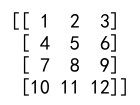Append to Numpy Array
Appending to a numpy array is a common task in data manipulation and analysis. This article will explore various methods to append data to numpy arrays using the numpy library in Python. We will cover appending elements, rows, and columns, and discuss the performance implications of these operations.
Introduction to Numpy
Numpy is a fundamental package for scientific computing in Python. It provides support for large, multi-dimensional arrays and matrices, along with a large collection of high-level mathematical functions to operate on these arrays.
Installing Numpy
Before we dive into appending operations, ensure that numpy is installed in your Python environment:
pip install numpy
Basics of Numpy Arrays
Numpy arrays are homogeneous in nature, meaning they consist of elements of the same data type. They are also indexed by tuples of non-negative integers and have a fixed size at creation.
Creating a Numpy Array
Here is a simple example of how to create a numpy array:
import numpy as np
# Creating a numpy array
array = np.array([1, 2, 3])
print(array)
Output:

Appending Elements to a Numpy Array
Appending elements to a numpy array can be done using the np.append() function. This function returns a new array and does not modify the original array.
Example 1: Appending a Single Element
import numpy as np
# Original array
arr = np.array([1, 2, 3])
# Appending an element
new_arr = np.append(arr, 4)
print(new_arr)
Output:

Example 2: Appending Multiple Elements
import numpy as np
# Original array
arr = np.array([1, 2, 3])
# Appending multiple elements
new_arr = np.append(arr, [4, 5, 6])
print(new_arr)
Output:

Appending Rows to a Numpy Array
When dealing with multi-dimensional arrays, you might want to add rows to an existing array. This can also be achieved using the np.append() function, but you need to specify the axis parameter.
Example 3: Appending a Row to a 2D Array
import numpy as np
# Original array
arr = np.array([[1, 2, 3], [4, 5, 6]])
# Appending a row
new_row = [7, 8, 9]
new_arr = np.append(arr, [new_row], axis=0)
print(new_arr)
Output:

Example 4: Appending Multiple Rows
import numpy as np
# Original array
arr = np.array([[1, 2, 3], [4, 5, 6]])
# Appending multiple rows
new_rows = [[7, 8, 9], [10, 11, 12]]
new_arr = np.append(arr, new_rows, axis=0)
print(new_arr)
Output:

Appending Columns to a Numpy Array
Appending columns is similar to appending rows, but you need to adjust the axis parameter to axis=1.
Example 5: Appending a Column to a 2D Array
import numpy as np
# Original array
arr = np.array([[1, 2, 3], [4, 5, 6]])
# Appending a column
new_col = [7, 8]
new_arr = np.append(arr, [[7], [8]], axis=1)
print(new_arr)
Output:

Example 6: Appending Multiple Columns
import numpy as np
# Original array
arr = np.array([[1, 2, 3], [4, 5, 6]])
# Appending multiple columns
new_cols = [[7, 8], [9, 10]]
new_arr = np.append(arr, new_cols, axis=1)
print(new_arr)
Output:

Performance Considerations
Appending operations with numpy arrays can be costly in terms of performance, especially for large arrays. This is because numpy needs to create a new array and copy data from the old array to the new array each time an append operation is performed.
Example 7: Performance of Appending
import numpy as np
import time
# Large array
arr = np.arange(1000000)
# Timing append operation
start_time = time.time()
new_arr = np.append(arr, [1])
end_time = time.time()
print("Time taken to append:", end_time - start_time, "seconds")
Output:

Append to Numpy Array Conclusion
In this article, we explored various ways to append data to numpy arrays. While numpy provides the np.append() function for these operations, it is important to be aware of the performance implications when working with large arrays. For more efficient operations, consider pre-allocating arrays or using different data structures such as lists for append operations before converting them to numpy arrays.
This guide should serve as a comprehensive reference for appending data to numpy arrays using numpy in Python, and help you understand when and how to use these techniques effectively.